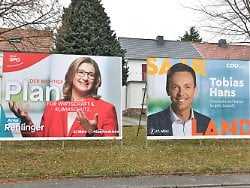Distance to the CDU is growing
SPD is clearly ahead in the survey in Saarland
02/16/2022, 11:50 a.m
A few weeks before the state elections, the Saarland SPD is able to further extend its poll lead over the CDU. The vote in Germany’s smallest land area is the start of a series of state elections, which is also crucial for the federal government’s ability to act.
Since Tuesday, citizens in Saarland have been able to vote by post: The state elections on March 27th are the first political position determination since the federal elections, especially for the CDU it is an important mood test after losing the chancellorship. According to a recent survey, however, the Christian Democrats in the Saar are increasingly falling behind.
Almost six weeks before election day, the SPD with top candidate Anke Rehlinger has significantly increased its lead – it comes to 38 percent. The CDU of Prime Minister Tobias Hans, on the other hand, is 29 percent. This emerges from the “Saarland trend” of the opinion research institute Infratest Dimap on behalf of the Saarland radio. While the SPD gained 5 percentage points compared to November 2021, the CDU gained 1 point.
Saarland has been governed by a grand coalition led by the CDU since 2012, which has had the prime minister since 1999. But the vote in Saarland is not only of nationwide importance for the Christian Democrats: It is the start of a new election marathon with four state elections this year, which will also decide on the ability of the traffic light coalition to act at federal level. SPD, Greens and FDP hope to be able to overturn the three CDU prime ministers in Saarland, Schleswig-Holstein and North Rhine-Westphalia in the elections. Because that would change the majority in the Bundesrat.
In the state chamber, the CDU and CSU with their prime ministers and government participation currently have an important say and can block traffic light plans. Union-led or co-governed countries have 51 out of a total of 69 votes. “The elections will therefore determine whether and how easily we can implement important legislative projects,” government circles say about the significance of the elections.
According to the current “Saarland trend”, the AfD comes in third place with 8 percent of the votes (minus 1.0). The Greens and FDP each lost 2 percentage points compared to November, but could get back into the state parliament with 6 percent of the votes each. For the FDP, this would be the first time since 2009, for the Greens since 2012. The left, on the other hand, would have to worry about their re-entry with 5 percent.
According to the survey, three coalitions would be possible with this election result: A grand coalition of CDU and Social Democrats led by the SPD, a so-called traffic light of SPD, Greens and FDP as well as red-red-green. The CDU, headed by then Prime Minister Annegret Kramp-Karrenbauer, clearly won the March 2017 election. She came to 40.7 percent ahead of the SPD with 29.6 percent. On March 1, 2018, Hans succeeded Kramp-Karrenbauer as head of government, who switched to federal politics as CDU general secretary.
